Harl’s: Beyond
hurdles
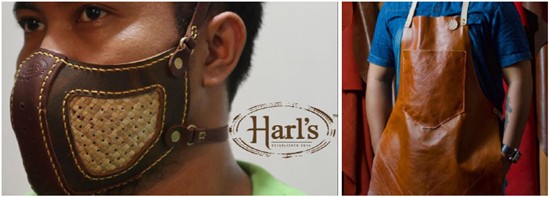
An
entrepreneur’s bounce back story amidst the COVID-19 pandemic
By
DTI-Regional Operations
Group
July 14, 2020
MAKATI CITY – The
coronavirus disease or COVID-19 has greatly affected many lives and
the country’s economy. As entrepreneurs struggle to adjust their
business strategies, it has become a challenging situation for them,
most especially the micro and small enterprises. Nonetheless, for
Harley Dave Beltran, owner of Handcrafted by Harl’s, every cloud has
a silver lining.
Known as the only micro
social enterprise in the country, Handcrafted by Harl’s in San
Pedro, Laguna started its business in 2014. This homegrown brand is
known in their innovative and unique genuine leather products such
as bags, coin purses, cellphone cases, gadget organizers, clocks,
stools, bow ties, belts, sandals, slippers, key chains, tags,
wallets, and other customized items.
With the aim to promote
local artistry, Harl’s produces crafts valuable to the community,
coinciding with its social responsibility to provide employment to
people with disability and underprivileged craftsmen. They train
aspiring artisans to produce products that would qualify in the
international market.
While some companies use
machines in certain phases of the manufacturing process, Harl’s
takes pride with their products that are purely and skillfully
handmade. What sets them apart from other leather brands is how they
use waste materials and genuine “rugged” type full grain leather to
create upcycled products. Their products have visible natural
leather markings on them such as a few scratches, discoloration, or
burn marks to give more character and uniqueness to the products.
They do not use linings and make only one of each product,
especially with their bags. Every batch produced has different sets
of leather choices and, these same items are not produced again. All
these are crafted proudly and dexterously by differently-abled
workers who are either mute, deaf, or cripple.
For the past years, Harl’s
handcrafted items are staple products at the regional and national
trade fairs and bazaars of the Department of Trade and Industry
(DTI). In 2018 at the DTI’s Sikat Pinoy National Trade Fair and
National Arts and Crafts Fair, differently-abled workers from Harl’s
conducted a leathercrafts workshop where guests can create their own
wallet, coin purse, and other leather goods.
But like any other
businesses, Harl’s was caught off guard when the pandemic happened.
“I had to unload the ship
for it to sail further. To put it simply, I needed to let go one of
my stores. I needed to prioritize what’s best for the company and
for my employees,” said Harley.
“We were not prepared for
the pandemic, but what can we do about it? Instead of constantly
thinking of problems and feeling dejected, I use my time during this
quarantine period to become more productive by thinking of new ways
for my business to survive and to sustain the needs of my
employees,” added Harley.
With these in mind, Harl’s
started crafting face masks made from leather and ticog mat, and
they call it maska. Ticog is harvested by an Abre Linea weaving
community in San Miguel, Leyte.
According to Harley, maska
doesn’t just provide safety but also comfort and durability because
of the materials used. One purchase of maska will not only feed one
PWD family but will also support San Miguel’s weaving community.
Moreover, through the
donations of customers and friends, Harley conducted the “Harl’s
COVID-19 Response” by distributing relief packages to several
underprivileged and PWD families in their area.
“Harl’s bounce back story
is very remarkable. We hope that his experience will help our MSMEs
to be inspired to move forward and start the process of putting
their businesses back on track. We, in the DTI, and with our
programs and activities for our MSMEs want them to be ready to
embrace the new normal,” said DTI CALABARZON Director Marilou Q.
Toledo.
DTI, through the Regional
Operations Group headed by Undersecretary Blesila Lantayona, has
been responsive to help MSMEs across the regions cope with the
pandemic through provision of various programs that will gear them
up as they face the new normal.
“Harl’s is here not to
have business; we’re here to inspire and survive. We continue to
serve our purpose by helping others,” said Harley.
Harley believes that your
action matters, so act now.
Quarantine curbs access
to information
By
KAROL ILAGAN
Philippine Center for Investigative Journalism
June 5, 2020
IS FREEDOM of information
one of the casualties of Covid-19?
Since April, the staff of
the Digital News Exchange (DNX), a community-based news site in
Bacolod City, has had zero success in getting a response to its
requests for information on Covid-19-related procurement and cash
aid.
They’re not the only ones.
Journalists around the country say both national and local
government agencies have either delayed or denied their information
requests. Officials, they said, were particularly reluctant to
release information that would hold them accountable for their
spending.
So far, only one in 10 of
the Covid-19 requests filed in the government’s eFOI portal between
March 13 and May 27, 2020 has been granted. Most of these requests
were for information on Covid-19 spending and financial assistance,
according to data from the Presidential Communications Operations
Office (PCOO), the manager of the eFOI platform where information
requests from national government agencies in the executive branch
are filed.
The PCOO has so far
received 1,332 requests from journalists and the public for
Covid-19-related information. More than half of those requests are
still being processed while about a third have been denied
supposedly because they were lodged in the wrong agency, the
requester did not provide his/her complete details, or the
information is already available online. (See Charts 1 and 2.)
Most of the denials were
requests for Covid-19 spending or Social Amelioration Program (SAP)
data from the Departments of Social Welfare and Development, Labor
and Employment, Interior and Local Government, and Budget and
Management. The PCOO refused to entertain these requests; instead it
advised requestors to ask their local government unit or call a DSWD
hotline number. (See Table 1 below.)
Like many journalists
around the country, DNX was particularly interested in how funds
allocated for Covid-19 relief have been spent. It is working on a
project called Money Watch to monitor how money from Bacolod City’s
P100-million calamity fund was allocated.
It’s been eight weeks
since the DNX staff sent the city government and its Department of
Social Services and Development a request for data on
pandemic-related spending. But up to now, they have not heard back.
City officials were not
always so stingy with information. In mid-March, as the lockdown
started, they responded promptly when DNX reporters asked about
Covid-19 preparations. This positive response prompted DNX reporters
to forego filing formal information requests for the time being.
They also feared that formal requests would be processed only when
the quarantine was already over. But in April, when DNX asked for
spending details, city officials were no longer as open as before.
“Finding sources is as difficult as catching a greased pig let
loose,” said Julius Mariveles, DNX’s executive editor.
Like city officials,
barangay officials, who are responsible for releasing cash
subsidies, delivering relief goods, and keeping the peace in their
communities, were also unwilling to give information. Mariveles says
being “out on the field” has become a common excuse for these
officials’ inability to provide data.
DNX has so far released
just one Money Watch story. It revealed discrepancies in the number
of targeted and actual beneficiaries of the city’s Covid-19
financial assistance, as well as the lack of reports from several
barangays.
The national government
has allocated at least P500 billion to address the impact of the
pandemic that has killed nearly a thousand Filipinos and placed
millions out of work because of the lockdown. This amount does not
include emergency funds that local governments can tap in addition
to any revenue and savings that they may also decide to use for
Covid-19-related expenses.
DNX’s small team of four
reporters tried their best to report on how Bacolod apportioned
public funds for coronavirus projects. But they were at their wit’s
end: With limited access to data and sources plus pandemic-related
constraints on field reporting, there was only so much they could
do.
In Metro Manila, Cebu, and
other parts of the country, journalists who shared their experiences
with PCIJ encountered varying levels of difficulty, depending on the
type of information they were requesting. While information about
the national government’s plan and budget to fight the virus are
readily available online, getting more detailed information on how
the plans are being implemented and the money spent is another
story.
Obtaining details about
Covid-19 spending at the local level has been especially difficult.
Unlike frontline agencies at the national level, local governments
do not proactively publish data on their websites. Moreover, with
press briefings now online, officials and their PR staff often
screen questions from the media, making it harder for reporters to
demand answers.
Since March, when
government offices were wholly or partly closed, most routine
requests for information have not been processed. The Philippines is
among many governments in the world that had to suspend the
processing of freedom-of-information or FOI requests because of the
pandemic.
The PCOO has so far issued
four advisories notifying offices in the executive branch of the
suspension of FOI processing. The advisories apply only to agencies
covered by Executive Order 2, s. 2016, which laid out the Duterte
administration’s FOI guidelines.
On June 1, PCOO lifted the
suspension of FOI processing, except in areas under Enhanced
Community Quarantine (ECQ). But it said agencies with sufficient
capacity can go ahead and process FOI requests despite quarantine
regulations.
The other branches of
government – Congress, the judiciary and local governments – were
not covered by the suspension, but their responses to information
requests were understandably slowed down because offices have not
been in full operation for at least 10 weeks. Although the ECQ in
Metro Manila was lifted on June 1, government offices still follow
alternative work arrangements, which means shortened hours or
suspension of certain services.
These measures have
exacerbated delays in the release of information crucial for holding
government accountable. For example, for over a year now, PCIJ’s
longstanding request for the statements of assets of national
government officials has been pending because the Office of the
Ombudsman has yet to issue guidelines for releasing such documents.
To be sure, a number of
national agencies, particularly those at the frontlines of Covid-19
response, have published records proactively, without the need for a
formal information request. Some departments, despite operating on a
skeleton staff, continue to accept and respond to requests by email.
But things were better
last year. From October 2018 to September 2019, the PCOO received
18,036 eFOI requests or an average of 347 requests per week. Nearly
half of these requests were granted. During the ongoing quarantine
until May 27, an average of 318 requests were lodged in the eFOI
portal every week but the success rate was just 17 percent.
According to Republic Act
6713 or the Code of Conduct and Ethical Standards for Public
Officials and Employees, public-records requests must be addressed
within 15 working days. Executive Order 2, s. 2016 gave executive
agencies more time -- not longer than 20 business days -- to respond
to such requests.
With the lockdown,
however, government agencies could not meet these deadlines. PCOO
Assistant Secretary Kristian R. Ablan says PCOO suspended the
required processing time because of the “justifiable concerns” of
FOI officers that they may be held liable if they fail to address
requests within the prescribed period.
FOI officers working from home said they lacked internet connection,
office equipment such as laptop computers and scanners and digital
copies of files. They also found it difficult to coordinate remotely
with record custodians.
The health and safety of the FOI officers were also factored in. “We
didn’t want to put their health at risk during ECQ,” he says.
Jenina Joy Chavez, co-convener of the Right to Know, Right Now!
Coalition (R2KRN), acknowledged these difficulties. Speaking at an
online forum on May 27, she said suspending FOI operations may be
necessary, but she also asked whether the government has done
anything to help agencies respond to information requests even
during a lockdown.
“Whether or not we’re in quarantine, the importance of the right to
information remains the same,” said Chavez. During the quarantine,
citizens yielded or entrusted power and resources to government, she
said. Transparency measures are needed so the public is able to seek
accountability and protection.
On March 29, R2KRN asked the inter-agency task force and departments
implementing the government’s Covid-19 action plan for a copy of the
plans and structure of the task force as well as for specific sets
of documents and data held by the departments of health, social
welfare, agriculture, labor, and budget, and the Philippine
Government Electronic Procurement System.
The status of this request is being published online and updated
weekly by the coalition members, including PCIJ. Most of the
information requested has been partially fulfilled, but most of the
releases are in PDFs, not in open-data or spreadsheet format that
make the numbers easier to analyze.
R2KRN publishes weekly reports on the quality of information being
provided by frontline agencies. Its May 5 report said that the
health department is perhaps the only government agency that
collects, processes, posts, and updates information on a regular
basis.
The coalition also raised questions about the completeness of the
data. For instance, the daily Covid-19 case counts do not give a
full picture of how the virus is spreading. Moreover, only 1,782 of
more than 23,000 registered health facilities have submitted details
on health capacity and needs. “With incomplete information, it is
not clear how capable the health system really is to deal with the
Covid-19 emergency,” R2KRN said.
In its May 12 report, R2KRN noted the sparse data released by the
DSWD’s Disaster Response Operations Monitoring and Information
Center (DROMIC), where updates on Covid-19 assistance are posted.
The DROMIC provides data broken down by province and city, but does
not say how many families have received assistance. It also does not
disaggregate new from cumulative data, which would have been helpful
in determining the rate of response by government and private
entities.
The attempt to publish the list of SAP beneficiaries was
commendable, said R2KRN.
However, most of the links are down. The list is also partial and
only includes areas that have reports from the DSWD’s field offices.
Information can be downloaded but only as PDFs.
Ryan Macasero, Rappler’s Cebu Bureau reporter, says he has been able
to obtain Covid-19-related information but the process has become
more laborious. Getting answers from officials, who may only be
reached through virtual press briefings or call and chat, has taken
more time and effort.
“It makes their lives easier, but our jobs more difficult,” he says.
What seems to work, Macasero says, is when many reporters ask the
same question.
“We back each other up in the agencies’/office’s official media
group chats and say we have the same question to try to emphasize
that it’s important they answer us regarding these questions,
because it’s information the public needs to know.” (With additional
research by Arjay Guarino, PCIJ, June 2020)
Before Covid-19,
Philippine jails already a death trap
Human rights advocates
believe that numbers will still increase and the full force of
Covid-19 is yet to be felt. They also call for transparency in
releasing death and infection rates to help craft policies and
mitigate the spread of false information.
By
AIE BALAGTAS SEE, Philippine Center for Investigative
Journalism
May 5, 2020
AN AVERAGE of 50 to 60 prisoners have died in the New Bilibid Prison
(NBP) every month for the past six months but only one death in
April has been attributed to Covid-19.
For the Bureau of Corrections (Bucor) the death toll in February,
March, and April was still within the range of monthly deaths in the
last quarter of 2019 to early 2020. The pandemic has ravaged the
country since March, with local transmission of the coronavirus
taking place as early as February. Humanitarian groups have since
warned of its catastrophic effect on the country’s prison system.
“It still falls under our average death rate for the past six
months,” Bucor spokesperson Gabriel Chaclag said in a phone
interview.
The high death rate, Chaclag said, was proportional to Bilibid’s
huge population, currently at 28,000. The population could create
from 11 to 14 barangays. Chaclag claimed that if they have lower
population, then they will have fewer deaths.
Bilibid is one of Bucor’s seven facilities for convicts. It had
recorded one to three deaths daily from October 2019 to April 2020,
noted Chaclag. Most came from the maximum-security compound, which
was designed for 6,000 but currently holds 19,000 men. Chaclag said
that the cause of these deaths varied, citing illnesses such as
cancer and heart failure as major ones.
“Loneliness, nightmares, and accidents” were also seen as reasons
for these deaths according to Chaclag.
Prisoners in extremely congested jail facilities live in deplorable
conditions, lacking proper health care, hygiene, and nutrition.
Human rights advocates have called for the early release of elderly
and sickly detainees. They have also pushed for making available
information on death and infection rates.
With Covid-19 breaching Bilibid walls, the deaths are sowing panic
and paranoia among disgruntled detainees who, according to an
insider, fear that the virus has already exploded within prison
compounds.
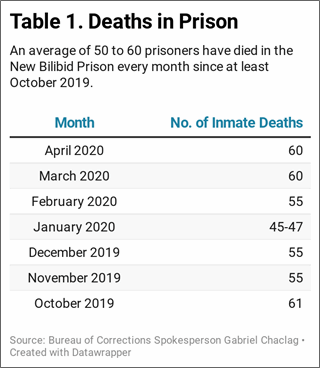 The lone Covid-related death from NBP was reported on April 23.
There have been no confirmed Covid-19 cases in Bilibid since, but at
least 44 inmates have been in quarantine, Chaclag confirmed. Four of
them were tested for the virus, with results yet to be released.
The lone Covid-related death from NBP was reported on April 23.
There have been no confirmed Covid-19 cases in Bilibid since, but at
least 44 inmates have been in quarantine, Chaclag confirmed. Four of
them were tested for the virus, with results yet to be released.
Health undersecretary Maria Rosario Vergeire, in a phone interview,
said that only one NBP inmate had tested positive for coronavirus as
of May 4.
A prison insider said bodies were piling up in NBP’s old isolation
ward called Dorm 1D. In late April, at least “20 bodies emitting
foul odor” were stacked there. On May 1, the insider added, three
men died after the NBP hospital ran out of oxygen.
“The inmates plan to hold a noise barrage but Bucor guards
threatened to shoot them,” the insider said.
Chaclag denied this, saying those “who have agenda” should stop
weaving stories that sow paranoia, which could lead to a riot in NBP.
Bodies were not piling up, he said. There were days when the funeral
parlor could not retrieve them because the cause of death was
unknown. “We had to wait for the crematorium personnel to pick them
up,” he explained.
Guidelines issued by the Health department stated that deaths with
unknown causes shall be treated as Covid cases and the corpse
cremated within 12 hours.
Six to five NBP inmates who died in their dormitories were cremated
last month. This is not a known practice in NBP. Bodies without
cause of death were usually autopsied and kept by funeral parlors
until someone claimed them.
Chaclag said that unclaimed bodies in the past were either buried in
the NBP cemetery or were taken advantage of by funeral parlors who
sold them to operators of “sakla,” a form of illegal gambling
carried out during wakes to help families raise funds for burial
expenses. In the case of unclaimed inmates, the earnings simply went
to the pockets of the syndicates.
Old conditions and new virus, a lethal mix
Inmate deaths is a decades-old problem at the New Bilibid Prison.
The global pandemic merely reopened the old Pandora’s box.
The national penitentiary was already in the spotlight last year
because of the alarming number of deaths there. Henry Fabro, the
Bilibid hospital chief, said one prisoner there dies each day.
Humanitarian groups have long blamed overpopulation, poor hygiene,
lack of proper food, and limited access to health care for the
lamentable condition. The calls to depopulate jails have only grown
louder with the coronavirus now part of the equation.
Rights advocates have called for the release of vulnerable inmates,
saying infections in detention areas might risk jail staff and
visitors, and can potentially lead to the reinfection of the general
public.
One of these advocates, Raymund Narag, an associate professor at
Southern Illinois University and expert in Philippine jails, told
PCIJ that there should be transparency in dealing with these
problems.
“It is their moral and legal obligation to be transparent. It is the
only way to mitigate the spread of false information. It is also
helpful in crafting policies if information are timely and
accurately provided,” Narag said.
Death and infection rates in detention facilities have always been
difficult to obtain. Like Narag, Human Rights Watch has called for
transparency after learning that one detainee dies every week in
Quezon City Jail since the coronavirus hit the facility last March.
Paul Borlongan, chief doctor of the Bureau of Jail Management and
Penology (BJMP), which supervises city jails, also claims that
BJMP’s death statistics is still “acceptable.”
In recent years, from 300 to 800 detainees have died in BJMP
annually. “So far, I can say that our death statistics is still
acceptable,” Borlongan said, adding that, “we expect 20 to 40 per
week and sometimes 60 to 80 per month.”
Clash of statistics
Transparency is not the only problem. A clash of statistics among
government agencies, and between the local and national governments,
is adding to the confusion.
According to Usec. Vergeire, there were 249 Covid-positive inmates
in jails and prisons as of May 3. Of these, 187 were in Cebu City
Jail, 49 in the Correctional Institute for Women in Mandaluyong, 12
in Quezon City Jail, and one in Bilibid.
The facilities that appear to be the hardest hit are the most
congested. Cebu City Jail is overpopulated by 1,000 percent and has
the highest number of inmates at 6,237. Quezon City Jail is the
third most crowded with 3,821 inmates as of March 2020.
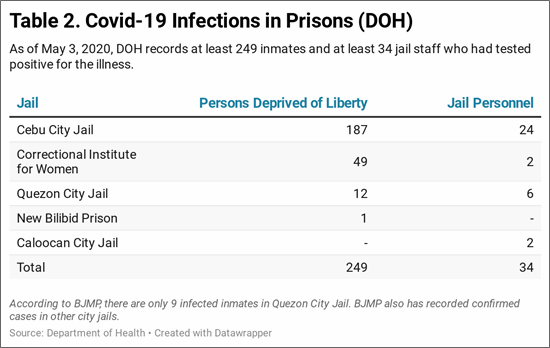
As far as BJMP is concerned, only nine inmates – not 12 – from
Quezon City Jail are considered Covid-positive patients. Borlongan
surmised that the three other inmates in DOH’s list were those whose
deaths were considered “possible Covid” cases because they had
flu-like symptoms or pulmonary problems.
As of April 27, BJMP has recorded a total of 195 inmates and 34 jail
staff who tested positive for Covid-19. Five jail personnel had
recovered while none of the inmates have yet to be cleared of the
illness. BJMP also documented cases in Mandaue City Jail, Marikina
City Jail, Pasay City Jail, and Mandaluyong City Jail. These jails
are not in the DOH list.
The City Reformatory Center in Zamboanga City was also reported to
have Covid-positive cases. BJMP’s Borlongan said he has not received
the official report about these cases.
Infections were also reported in the Cebu Provincial Jail, which is
managed by the local government.
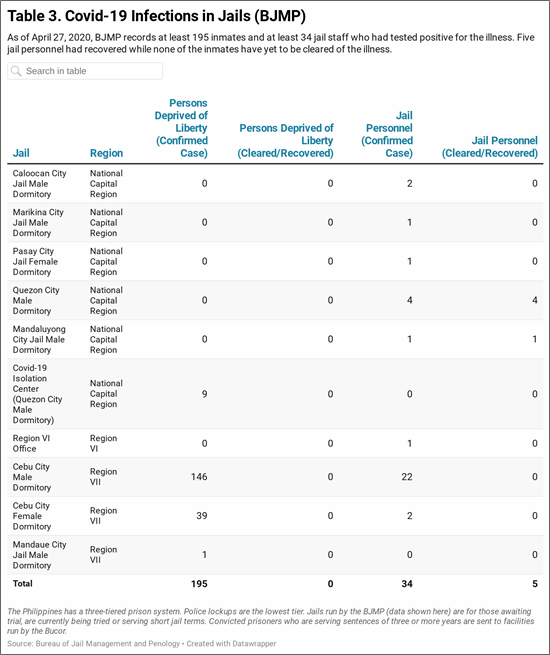
A Bucor official, who requested anonymity, also complained of slow
and unreliable test results from the Health department. “We have to
repeat the test each time they release results to us. It’s a waste
of resources. Once, our staff tested positive but when the
Philippine Red Cross rechecked it, the results were negative.”
The World Health Organization, International Committee of the Red
Cross, and the Health department are working alongside Bucor and
BJMP in setting up quarantine facilities for infected detainees.
DOH Undersecretary Vergeire said they also plan to “conduct targeted
testing, provide treatment and management of cases, and ensure that
infection control measures are in place to prevent the spread of
Covid-19 in penal and correctional facilities.”
Prisoner release and other urgent calls
From March 17 to April 29, almost 10,000 inmates have been released
as bid to curb the spread of coronavirus in jails. The Supreme Court
has also allowed the release of pre-trial detainees in jail for
crimes punishable with six-month incarceration and below. A
reduction of bail has been recommended for non-convicts facing
charges punishable with jail time of six months to 20 years.
Petitions seeking temporary freedom for the sick and elderly are
still pending approval.
Last March, Interior secretary Eduardo Año rejected calls to release
vulnerable inmates, saying jails were the “safest” place for them.
The growing number of Covid-19 cases now appear to disprove this
claim.
“If many people – prisoners, guards, their families, the people i[n]
neighborhoods around jails – die because of Covid-19, the massacre
is squarely the responsibility of government,” Human rights advocate
and Ateneo de Manila University professor Antonio La Viña said.
Narag and La Viña believe the numbers will still increase and the
full force of Covid-19 is yet to be felt. “I believe that there will
be multiple bombs that will explode. Many PDLs [persons deprived of
liberty] had been dying from many jails… only that it is not
reported as such. But once the news report will catch up, I will not
be shocked,” Narag said.
Warnings about the coronavirus being a bomb that could explode in
jails and prisons were made in early March. These fell on deaf ears
until infections began to manifest, with jails and prisons fast
becoming the next epicenters of the virus. “Our prisons will be
ground zero unless we decongest now,” said La Viña.
Narag and La Viña are urging the government to take swift actions,
stressing that the disease’s spread is a public issue and not only
the problem of the corrections and prison system. “We are already
faced by a problem that can kill us all,” Narag said. –PCIJ, May
2020
Aie Balagtas See is a freelance journalist working on human rights
issues. Follow her on Twitter (@AieBalagtasSee) or email her at
aie.bsee@gmail.com for comments.
340 skilled,
informal sector workers in Sogod get P4.3M livelihood aid
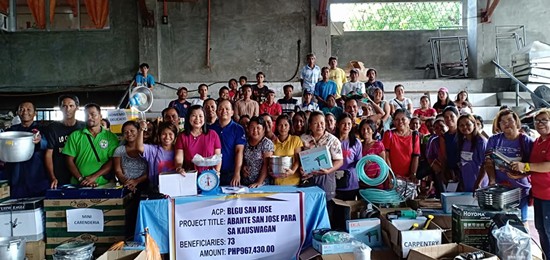
By
Norma Rae Costimiano,
DOLE-8
July 17, 2019
TACLOBAN CITY – The
Department of Labor and Employment Regional Office VIII through its
Southern Leyte Field Office has successfully awarded livelihood
assistance to some three hundred forty skilled and informal sector
workers from six barangays of Sogod last 27 June 2019 at Sogod
Gymnasium, Sogod, Southern Leyte.
The amount of livelihood
projects awarded during the turnover ceremony totaled to
P4,357,135.00 charged under the DOLE Integrated Livelihood Program (DILP)
funds of the regional office.
The approved livelihood
projects under the said funding include the following: Rice
Production Tractor with Machine Thresher and Blower amounting to
P200,000; Abante San Jose Para sa Kauswagan amounting to P967,430;
Micro Livelihood Project for Skilled Workers of Barangay Pandan
amounting to 782,585; Dugang Negosyong Panginabuhian para sa
Concepcion I amounting to P284,970; Starter Kits para sa Proyektong
Panginabuhian sa Barangay San Roque amounting to 1,065,050;
Sustainable Livelihood Development Project of Barangay Milagroso
amounting to 447,905; and Micro Livelihood Project of Barangay Rizal
amounting to P609,195.
Different tools, equipment
and materials were released to the beneficiaries for the
implementation of the micro livelihood and diversified projects
which include Dressmaking, Vulcanizing, Welding, Mini Carenderia,
Haircutting & Cosmetology, Barber Shop, Dried Fish Vending, Fruits &
Vegetables Vending, Painting Services and Rice Production, among
others.
Present to grace the
significant occasion were Atty. Cecilio I. Baleña, DOLE RO VIII OIC-Assistant
Regional Director, Ms. Marites Z. Viñas, DOLE-SLFO Head, Honorable
Jose Ramil Golo, Vice-Mayor of Sogod and Ms. Velma O. Duguil, Sogod
PESO Manager.
Also in attendance to
witness the simple ceremony were the chairpersons of the recipient
barangays, namely: Jeffrex R. Gan of Brgy. San Jose, Reynaldo A.
Paloguer of Brgy. Pandan, Lyn T. Guias of Brgy. Concepcion I,
Adelina P. Tadtad of Brgy. San Roque, Antonio S. Tagoon of Brgy.
Milagroso and Corneila M. Telin of Brgy. Rizal.
Atty. Baleña in his
message happily congratulated all the beneficiaries for their
starter kits. He likewise thanked the local government unit of Sogod
for being an active partner of DOLE RO VIII in delivering its
employment and livelihood programs in the municipality.
“Allow me to congratulate
all our beneficiaries for their new sources of income. I hope you
will do your best to be successful in your respective businesses.
And of course to our officials of LGU-Sogod, thank you for always
being supportive to our programs especially our livelihood program”,
said Atty. Baleña.
Vice-Mayor Golo in
response thanked DOLE RO VIII for all the help it extends to the
municipality.
“We are so blessed to have
DOLE as our strong partner in uplifting the lives of our
constituents here in Sogod. These livelihood assistance that our
workers received is a proof of how serious our government is in
serving the people especially those in need”, Hon. Golo said.
All the beneficiaries
present were happy and elated after receiving the livelihood aid.
The smiles on their faces were beaming, a sign of new hope and
determination to live better lives.
The six recipient
barangays were all first timers in availing livelihood assistance
from DOLE RO VIII.
◄◄home
I
next►►